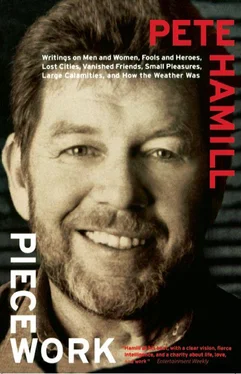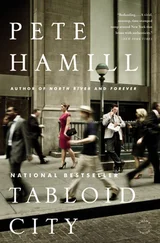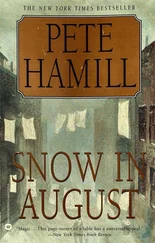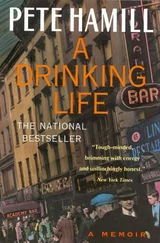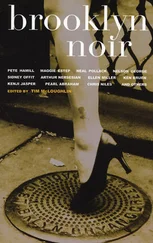Pete Hamill - Piecework
Здесь есть возможность читать онлайн «Pete Hamill - Piecework» весь текст электронной книги совершенно бесплатно (целиком полную версию без сокращений). В некоторых случаях можно слушать аудио, скачать через торрент в формате fb2 и присутствует краткое содержание. Год выпуска: 2009, ISBN: 2009, Издательство: Little, Brown and Company, Жанр: Современная проза, Публицистика, на английском языке. Описание произведения, (предисловие) а так же отзывы посетителей доступны на портале библиотеки ЛибКат.
- Название:Piecework
- Автор:
- Издательство:Little, Brown and Company
- Жанр:
- Год:2009
- ISBN:9780316082952
- Рейтинг книги:5 / 5. Голосов: 1
-
Избранное:Добавить в избранное
- Отзывы:
-
Ваша оценка:
- 100
- 1
- 2
- 3
- 4
- 5
Piecework: краткое содержание, описание и аннотация
Предлагаем к чтению аннотацию, описание, краткое содержание или предисловие (зависит от того, что написал сам автор книги «Piecework»). Если вы не нашли необходимую информацию о книге — напишите в комментариях, мы постараемся отыскать её.
offers sharp commentary on diverse subjects, such as American immigration policy toward Mexico, Mike Tyson, television, crack, Northern Ireland and Octavio Paz.
Piecework — читать онлайн бесплатно полную книгу (весь текст) целиком
Ниже представлен текст книги, разбитый по страницам. Система сохранения места последней прочитанной страницы, позволяет с удобством читать онлайн бесплатно книгу «Piecework», без необходимости каждый раз заново искать на чём Вы остановились. Поставьте закладку, и сможете в любой момент перейти на страницу, на которой закончили чтение.
Интервал:
Закладка:
But I insist on stating that in the course of our lives much has changed. When I was a kid in the Navy, stationed in Pensacola in 1954, the Supreme Court ruled on Brown v. Board of Education and banned segregation in the public schools. At the time, if you possessed the Congressional Medal of Honor and were black, you could not swim at the white beaches of Florida. Throughout the South, you could not sit in just any seat on just any bus; you could not walk through the front door of any American movie house, sit at any counter in just any American restaurant. There were separate washrooms and drinking fountains for blacks and whites. The White Citizens Councils seemed to own the night. In many places blacks were denied the right to vote through poll taxes, gerrymandering, or terrorism. Blacks could not attend “white” public schools, including white state universities that they helped support with taxes. Blacks and whites could not marry each other in many states and could not even fight each other in boxing rings in others. Radio stations segregated black music. Blacks seldom appeared on television and were cast in movies as domestics or feets-get-movin’ buffoons of the Stepin Fetchit variety. When I tell this to my children, they find it hard to believe.
This you must admit: your children and mine have grown up in a different United States. And, for all its flaws, a better one. De jure segregation is a memory (which is not to say that it doesn’t persist in a de facto form in housing and education). For the first time in American history, there is a substantial and expanding black middle class. As I write to you, the leading contender for the Democratic nomination for President is a black man named Jesse Jackson. Bill Cosby stars in and produces the highest-rated entertainment show in the country, Oprah Winfrey hosts the most popular talk show. Bryant Gumbel is at the top of the heap on the Today show. Eddie Murphy is one of the most successful stars in Hollywood feature films, and Michael Jackson, Lionel Richie, Whitney Houston, and Tina Turner sell millions of records to white fans as well as black. From 1977 to 1982 the number of black businesses increased almost 50 percent, from 230,000 to 340,000. They grossed $12.4 billion in 1982. More important, in 1964 there were 280 black elected public officials in the United States; today there are more than five thousand, over 60 percent of them in the South. The mayors of Los Angeles, Atlanta, New Orleans, Newark, Detroit, Washington, Philadelphia, and Chicago are black. Last year the nomination of Robert Bork to the United States Supreme Court was rejected because of the crucial opposition of white southern senators who were afraid of offending their new black constituents. True black power is being achieved.
But this was not accomplished without help. Twenty-five years have passed since James Baldwin shook the nation with The Fire Next Time, twenty-three years since Lyndon Johnson called for a War on Poverty, twenty years since the murder of Martin Luther King. Whatever its motives, white America (if it can be called that) was not indifferent. Billions of tax dollars have been spent by federal, state, and local governments to repair the injuries of racism. You might reply that the sum was a pittance in comparison with the gross national product; certainly far more dollars have been poured down the insatiable maw of the defense racket than were spent to reduce poverty. But the fact remains that those billions were spent. Few countries in the history of this planet have made such an effort for their most damaged citizens; it doesn’t matter if the motives were guilt, fear, or (as you believe) a cynical form of bribery to head off full-scale revolt. What does matter is that the effort was made. And continues.
But we have come to understand one terrible truth: for the black Underclass, life in the United States is infinitely worse. For them, King, Malcolm, and the rest have died in vain.
Yes, there is a white underclass and an expanding Hispanic underclass. But the first is relatively contained; the fall into poverty, homelessness, welfare is generally temporary. Hispanics are a separate category too, for the indexes of their poverty reflect some of the traditional problems of immigrants: the lack of knowledge of the English language, larger family size, a dependence upon agriculture or nonunion industries for jobs.
But most black Americans are not recent arrivals. Blacks speak the American language. Millions of American blacks have long since left behind the bondage of the farm. The old Jim Crow unions are gone (even in the building trades there is a begrudging acceptance of blacks). But in the past decade American cities have witnessed a new phenomenon: newly arrived Koreans, Pakistanis, Cubans, Haitians, Greeks, Vietnamese, Russian Jews, West Indians, even Afghans are moving past American blacks. Japanese-Americans — whose parents were thrown into American concentration camps during World War II — are winning disproportionate shares of college scholarships and moving to the top in many professions. And the black Underclass seems incapable of progress.
Need I recite the sad statistics? I must. I realize that such numbers have as much to do with the dailiness of human lives as a box score has to do with a ball game. But we need to know them. They tell us about our failure — mine and yours.
Almost 30 percent of all black American families are now living below the federal poverty line of $10,989 a year for a family of four (compared with 8 percent of whites). In New York City it is estimated that 60 percent of black youths never finish high school, in a time when even a high school diploma is barely sufficient to function in the job market. The national infant-mortality rate is 50 percent higher among blacks than among whites; eleven thousand black infants died in 1984, and in New York last year, after the advent of crack, infant death increased by 20 percent.
The living face even greater hazards. One third of black New Yorkers between the ages of five and nineteen are victims of homicide, and nationally the leading cause of death for black men between the ages of sixteen and thirty-four is murder. Not smallpox. Not tuberculosis. Not influenza. Not one of the ancient plagues of the earth. Murder.
Last year, AIDS killed more black junkies in New York than it did homosexual men, and nationally blacks now account for 24 percent of all AIDS cases (roughly twice the proportion of blacks in the general population). Blacks account for half of the heterosexual AIDS cases. Half the female AIDS victims are black; two of three infants born with AIDS are black. According to the Centers for Disease Control, a black woman is thirteen times more likely to contract AIDS than a white woman. Of the fifty thousand women in New York City who are infected with the AIDS virus (but as yet free of the symptoms of the disease), 80 percent are black or Hispanic. Doctors expect that eventually all will die. AIDS researcher Beny J. Primm said at last year’s national convention of the Urban League: “My friends are afraid that they will be called racist if they cite these statistics. But I have said it is better to be called a racist now than to be called a conspirator in a conspiracy of genocide five or ten years from now, when many, many blacks will die because of your silence today.” In a speech last year, Dr. Donald R. Hopkins, then deputy director of the CDC, summed it up: “This disease is the fifth horseman of the Apocalypse in our nation’s minority communities.”
But the extraordinary hazards of black life in the Underclass are not limited to murder and AIDS. Blacks have more heart disease than whites, more cancer, more cirrhosis. Fifty percent of older black women are obese (compared with one third of the whites), and blacks have hypertension and strokes at twice the rate of whites. As you might expect, whites live about six years longer than blacks.
Читать дальшеИнтервал:
Закладка:
Похожие книги на «Piecework»
Представляем Вашему вниманию похожие книги на «Piecework» списком для выбора. Мы отобрали схожую по названию и смыслу литературу в надежде предоставить читателям больше вариантов отыскать новые, интересные, ещё непрочитанные произведения.
Обсуждение, отзывы о книге «Piecework» и просто собственные мнения читателей. Оставьте ваши комментарии, напишите, что Вы думаете о произведении, его смысле или главных героях. Укажите что конкретно понравилось, а что нет, и почему Вы так считаете.
